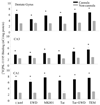Intra-cornu ammonis 1 administration of the human immunodeficiency virus-1 protein trans-activator of transcription exacerbates the ethanol withdrawal syndrome in rodents and activates N-methyl-D-aspartate glutamate receptors to produce persisting spatial learning deficits
- PMID: 19619615
- PMCID: PMC2773563
- DOI: 10.1016/j.neuroscience.2009.07.025
Intra-cornu ammonis 1 administration of the human immunodeficiency virus-1 protein trans-activator of transcription exacerbates the ethanol withdrawal syndrome in rodents and activates N-methyl-D-aspartate glutamate receptors to produce persisting spatial learning deficits
Abstract
Human immunodeficiency virus-1 (HIV-1) infection may produce neurological deficits, such as cognitive decline, that may be worsened by concurrent ethanol (EtOH) abuse. Among the many biochemical cascades likely mediating HIV-1-associated neuronal injury is enhancement of N-methyl-d-aspartate (NMDA) receptor function and progression to excitotoxicity, an effect that may be directly or indirectly related to accumulation in brain of the HIV-1 trans-activator of transcription (Tat) factor. The present studies were designed to examine the hypothesis that binge-like EtOH pre-exposure would enhance effects of Tat on NMDA receptor function. These studies employed a modified in vivo binge EtOH exposure regimen designed to produce peak blood EtOH levels (BEL) of <200 mg/dl in adult male rats and were designed to examine effects of intra-hippocampal injection of Tat (0.5 microl/500 pM/2 min) on EtOH withdrawal-related behavior, spatial learning, and histological measures. Unilateral cannulae were implanted into the cornu ammonis 1 (CA1) pyramidal cell layer of animals prior to beginning a 4-day binge EtOH regimen. EtOH was administered via intragastric intubation ( approximately 3.0-5.0 g/kg) with dose determined by behavioral ratings of intoxication daily for 4 days (at 08:00, 16:00, and 24:00 h). EtOH withdrawal behaviors were monitored 12 h after the last administration of EtOH. Morris water maze learning was assessed during the following 4 days, at which times brains were harvested for autoradiographic measurement of NMDA receptor density and neuroinflammation. Maximal BELs of 187.69 mg/dl were observed 60 min after EtOH administration on day 2 of the regimen. In contrast, peak BELs of approximately 100 mg/dl were observed 60 min after EtOH administration on day 4 of the regimen, suggesting development of metabolic tolerance. Significant behavioral abnormalities were observed in EtOH withdrawn animals, including tremor and seizures. Intra-CA1 region injection of Tat significantly potentiated EtOH withdrawal behavioral abnormalities, an effect that was reduced by MK-801 pre-exposure. While EtOH withdrawn animals showed learning similar to control animals, EtOH withdrawn animals that received intra-CA1 Tat injection demonstrated persisting deficits in spatial learning on days 3 and 4 of training, effects that were markedly reduced by administration of the competitive NMDA receptor antagonist MK-801 30 min prior to Tat injection. No changes in [(3)H]MK-801 binding were observed. Binding density of [(3)H]PK11195, a ligand for peripheral benzodiazepine receptors expressed on activated microglia, was elevated proximal to cannula tracks in all animals, but was not altered by EtOH or Tat exposure. These findings suggest that EtOH abuse and/or dependence in HIV-positive individuals may promote HIV-1-associated cognitive deficits by altering NMDA receptor function in the absence of microglial activation or neuroinflammation.
Figures






Similar articles
-
Long-term ethanol and corticosterone co-exposure sensitize the hippocampal ca1 region pyramidal cells to insult during ethanol withdrawal in an NMDA GluN2B subunit-dependent manner.Alcohol Clin Exp Res. 2013 Dec;37(12):2066-73. doi: 10.1111/acer.12195. Epub 2013 Jul 24. Alcohol Clin Exp Res. 2013. PMID: 23889203 Free PMC article.
-
Mifepristone pretreatment reduces ethanol withdrawal severity in vivo.Alcohol Clin Exp Res. 2013 Aug;37(8):1417-23. doi: 10.1111/acer.12093. Epub 2013 Mar 25. Alcohol Clin Exp Res. 2013. PMID: 23527822 Free PMC article.
-
Cytotoxic effects of exposure to the human immunodeficiency virus type 1 protein Tat in the hippocampus are enhanced by prior ethanol treatment.Alcohol Clin Exp Res. 2004 Dec;28(12):1916-24. doi: 10.1097/01.alc.0000148108.93782.05. Alcohol Clin Exp Res. 2004. PMID: 15608609
-
Ethanol exposure and withdrawal sensitizes the rat hippocampal CA1 pyramidal cell region to beta-amyloid (25-35)-induced cytotoxicity: NMDA receptor involvement.Alcohol Clin Exp Res. 2005 Nov;29(11):2063-9. doi: 10.1097/01.alc.0000187591.82039.b2. Alcohol Clin Exp Res. 2005. PMID: 16340465
-
Sex differences in the neurotoxic effects of adenosine A1 receptor antagonism during ethanol withdrawal: reversal with an A1 receptor agonist or an NMDA receptor antagonist.Alcohol Clin Exp Res. 2008 Jul;32(7):1260-70. doi: 10.1111/j.1530-0277.2008.00681.x. Alcohol Clin Exp Res. 2008. PMID: 18482156 Free PMC article.
Cited by
-
D1/NMDA receptors and concurrent methamphetamine+ HIV-1 Tat neurotoxicity.J Neuroimmune Pharmacol. 2012 Sep;7(3):599-608. doi: 10.1007/s11481-012-9362-3. Epub 2012 May 3. J Neuroimmune Pharmacol. 2012. PMID: 22552781 Free PMC article.
-
Long-term ethanol and corticosterone co-exposure sensitize the hippocampal ca1 region pyramidal cells to insult during ethanol withdrawal in an NMDA GluN2B subunit-dependent manner.Alcohol Clin Exp Res. 2013 Dec;37(12):2066-73. doi: 10.1111/acer.12195. Epub 2013 Jul 24. Alcohol Clin Exp Res. 2013. PMID: 23889203 Free PMC article.
-
Expression of HIV-Tat protein is associated with learning and memory deficits in the mouse.Behav Brain Res. 2012 Apr 1;229(1):48-56. doi: 10.1016/j.bbr.2011.12.019. Epub 2011 Dec 20. Behav Brain Res. 2012. PMID: 22197678 Free PMC article.
-
Group 1 mGlu-family proteins promote neuroadaptation to ethanol and withdrawal-associated hippocampal damage.Drug Alcohol Depend. 2015 Nov 1;156:213-220. doi: 10.1016/j.drugalcdep.2015.09.013. Epub 2015 Sep 26. Drug Alcohol Depend. 2015. PMID: 26442908 Free PMC article.
-
Mifepristone pretreatment reduces ethanol withdrawal severity in vivo.Alcohol Clin Exp Res. 2013 Aug;37(8):1417-23. doi: 10.1111/acer.12093. Epub 2013 Mar 25. Alcohol Clin Exp Res. 2013. PMID: 23527822 Free PMC article.
References
-
- Acheson SK, Richardson R, Swartzwelder HS. Developmental changes in seizure susceptibility during ethanol withdrawal. Alcohol. 1999;18(1):23–26. - PubMed
-
- Bagby GJ, Stoltz DA, Zhang P, Kolls JK, Brown J, Bohm RP, Jr, Rockar R, Purcell J, Murphey-Corb M, Nelson S. The Effect of Chronic Binge Ethanol Consumption on the Primary Stage of SIV Infection in Rhesus Macaques. Alcoholism: Clin & Exp Res. 2003;27(3):495–502. - PubMed
-
- Behnisch T, Francesconi W, Sanna P. HIV secreted protein Tat prevents long-term potentiation in the hippocampal CA1 region. Brain Res. 2004;1012:187–189. - PubMed
-
- Casellas P, Galiegue S, Basile AS. Peripheral benzodiazepine receptors and mitochondrial function. Neurochem Int. 2002;40:478–486. - PubMed
Publication types
MeSH terms
Substances
Grants and funding
LinkOut - more resources
Full Text Sources
Miscellaneous

